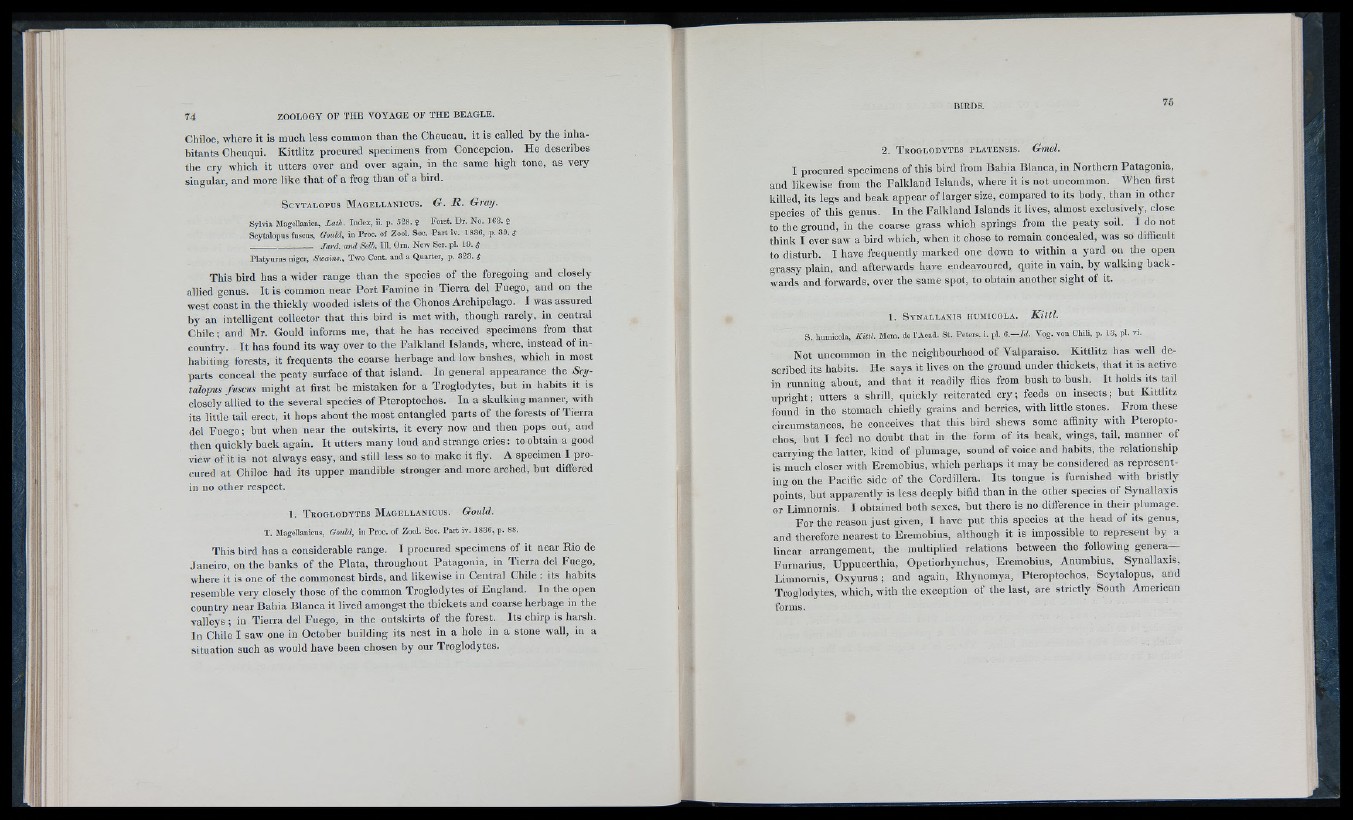
Chiloe, where it is much less common than the Cheucau, it is called by the inhabitants
Cheaqui. Kittlitz procured specimens from Concepcion. He describes
the cry wbich it utters over and over again, in the same high tone, as very
singular, and more like that of a frog than of a bird.
S c y t a l o p u s M a g e l l a n i c u s . G. R . Gray.
Sylvia Magellaiiica, Lath. Index, ii. p. 528. j Forst. Dr. No. 163. ?
Scytalopus fuscus, Gould, in Proc. of Zool. Soc. Part iv. 1836, p. 39. $
_______________ Jard. and Selb. 111. Om. New Ser. pi. 19. $
Platyurus niger, Swains., Two Cent, and a Quarter, p. 323. $
This bird has a wider range than the species of the foregoing and closely
allied genus. It is common near Port Famine in Tierra del Fuego. and on the
west coast in the thickly wooded islets of the Chonos Archipelago. I was assured
by an intelligent collector that this bird is met with, though rarely, in central
Chile; and Mr. Gould informs me, that he has received specimens from that
country. It has found its way over to the Falkland Islands, where, instead of in-
habiting forests, it frequents the coarse herbage and low hushes, which in most
parts conceal the peaty surface of that island. In general appearance the Scytalopus
fuscus might at first he mistaken for a Troglodytes, hut in habits it is
closely allied to the several species of Pteroptochos. In a skulking manner, with
its little tail erect, it hops about the most entangled parts of the forests of Tierra
del Fuego; but when near the outskirts, it every now and then pops out, and
then quickly back again. It utters many loud and strange cries: to obtain a good
view of it is not always easy, and still less so to make it fly. A specimen I procured
at Chiloe had its upper mandible stronger and more arched, hut differed
in no other respect.
1 , T r o g l o d y t e s M a g e l l a n ic u s . Gould.
T. Magellanicus, Gould, in Proc. of Zool. Soc. P art iv. 1836, p. 88.
This bird has a considerable range. I procured specimens of it near Rio de
Janeiro, on the hanks of the Plata, throughout Patagonia, in Tierra del Fuego,
where it is one of the commonest birds, and likewise in Central Chile : its habits
resemble very closely those of the common Troglodytes of England. In the open
country near Bahia Blanca it lived amongst the thickets and coarse herbage in tlie
valieys ; in Tierra del Fuego, in the outskirts of the forest. Its chirp is harsh.
In Chile I saw one in October building its nest in a hole in a stone wall, in a
situation such as would have been chosen by our Troglodytes.
2 . T r o g l o d y t e s p l a t e n s i s , Gmel.
I procured specimens of this bird from Bahia Blanca, in Northern Patagonia,
and likewise from the Falkland Islands, where it is not uncommon. When first
killed, its legs and beak appear of larger size, compared to its body, than in other
species of this genus. In the Falkland Islands it lives, almost exclusively, close
to the ground, in the coarse grass which springs from the peaty soil. I do not
think I ever saw a bird which, when it cliose to remain concealed, was so difficult
to disturb. I have frequently marked one down to within a yard on the open
grassy plain, and afterwards have endeavoured, quite in vain, by walking backwards
and forwards, over the same spot, to obtain another sight of it.
1 . S y n a l l a x i s h u m ic o l a . K ittl.
s. humicola, K iu l. Mem. de I'A cad. St. Peters. 1. pi. C.— Id . Vog. von Chili, p. 13, pi. vi.
Not uncommon in the neighbourhood of Valparaiso. Kittlitz has well described
its habits. He says it lives on the ground under thickets, that it is active
in running about, and that it readily flies from hush to hush. It holds its tail
upright; utters a shrill, quickly reiterated cry; feeds on insects; but Kittlitz
found in the stomach chiefly grains and berries, with little stones. From these
circumstances, lie conceives that this bird shews some affinity with Pteroptochos.
hut I feel no doubt that in the form of its beak, wings, tail, manner of
carrying the latter, kind of plumage, sound of voice and habits, the relationship
is much closer witli Eremobius. which perhaps it may be considered as representing
on the Pacific side of the Cordillera. Its tongue is furnished with bristly
points, hut apparently is less deeply bifid than in the other species of Synallaxis
or Limnornis. I obtained both sexes, hut there is no difference in their plumage.
For the reason just given, I have put this species at the head of its genus,
and therefore nearest to Eremobius, although it is impossible to represent by a
linear arrangement, the multiplied relations between the following genera—
Furnarius, Uppucerthia, Opetiorhynchus, Eremobius, Anumbius, Synallaxis,
Limnornis, Oxyurus; and again, Rliynomya, Pteroptochos, Scytalopus, and
Troglodytes, which, with the exception of tlie last, are strictly South American
forms.